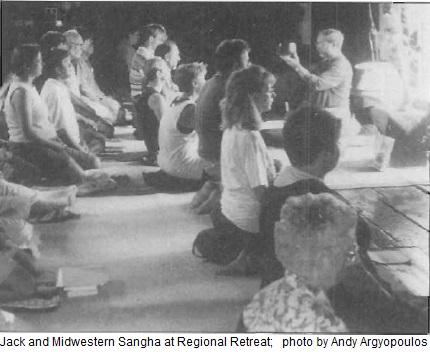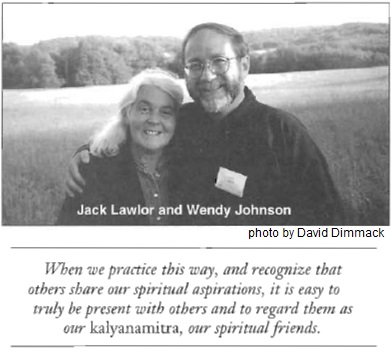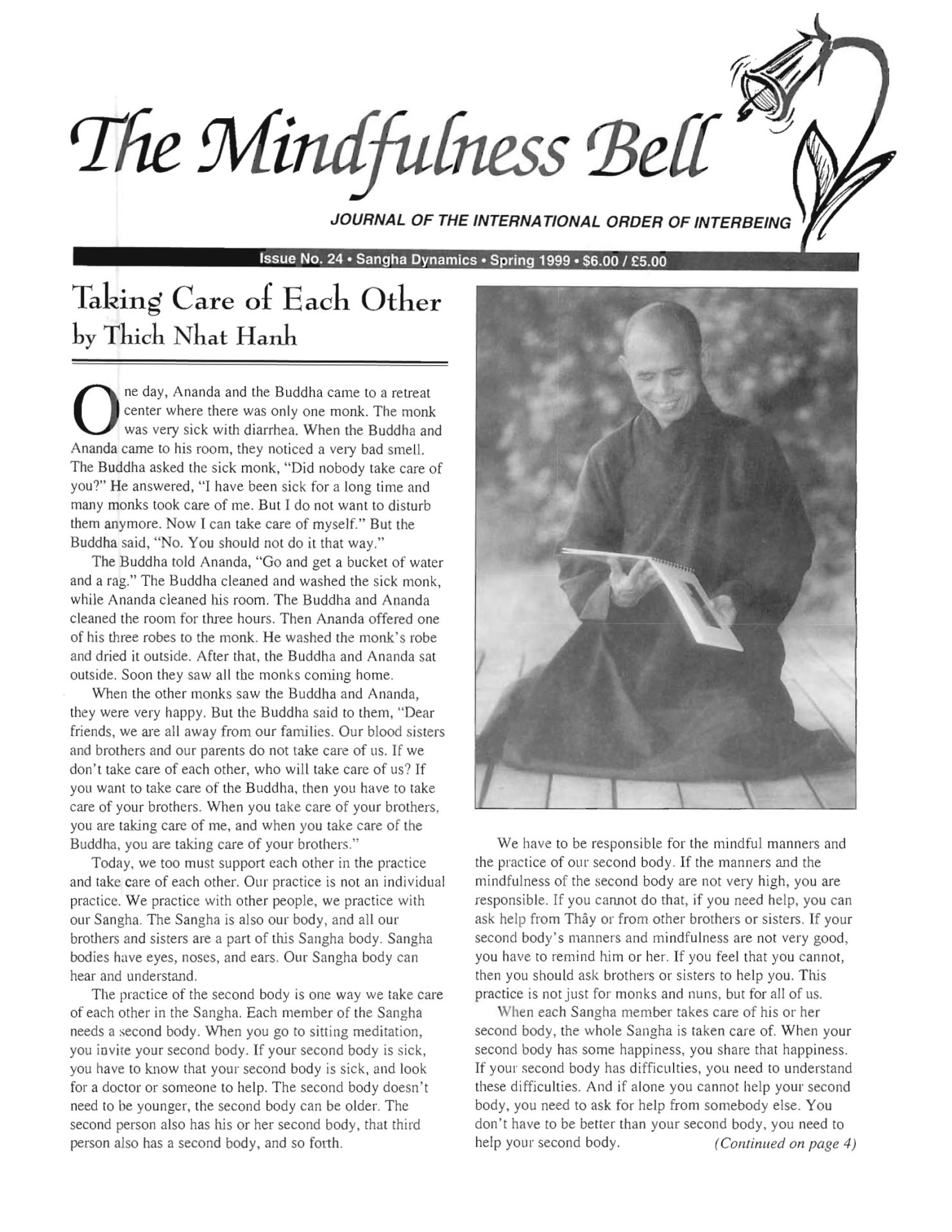By Jack Lawlor
Even the Buddha’s Sangha experienced difficulties. His cousin, Devadatta, once attempted to divide the Sangha and lead it himself. And the Buddha himself could not mediate the dispute over etiquette between the Precept master and the Sutra master at Kosambi-at least, not initially. The Upakkilesa Sutta describes how the bhikkhus at Kosambi were “quarreling and brawling and deep in dispute, stabbing each other with verbal daggers.” The Buddha’s verse on this dispute reveals how keenly he observed what was happening:
When many voices shout at once
None considers himself a fool;
By Jack Lawlor
Even the Buddha's Sangha experienced difficulties. His cousin, Devadatta, once attempted to divide the Sangha and lead it himself. And the Buddha himself could not mediate the dispute over etiquette between the Precept master and the Sutra master at Kosambi-at least, not initially. The Upakkilesa Sutta describes how the bhikkhus at Kosambi were "quarreling and brawling and deep in dispute, stabbing each other with verbal daggers." The Buddha's verse on this dispute reveals how keenly he observed what was happening:
When many voices shout at once
None considers himself a fool;
Though this Sangha is being split
None thinks himself to be at fault.
They have forgotten thoughtful speech,
They talk obsessed by words alone.
Uncurbed their mouths, they bawl at will;
None knows what will lead him to so act.
"He abused me, he struck me,
He defeated me, he robbed me"
-In those who harbor thoughts like these
Hatred will never be allayed.
For in this world, hatred is never
Allayed by further acts of hate.
It is allayed by non-hatred:
That is the fixed and ageless law.
Those others do not recognize
That here we should restrain ourselves.
But those wise ones who realize this
At once end all their enmity.
Many Western Sanghas have also experienced difficulty. Ordained teachers in various traditions have engaged in sexual misconduct and selfish financial practices, and disputes have arisen out of personality differences and opinions on how the Sangha should be "led." In response, we often want to reach beyond basic mindfulness practices to resources from other venues, such as conflict resolution techniques used by businesses or other spiritual traditions. If carefully modified to address the people involved, these can sometimes help lessen difficulty in a Sangha, but there are limitations on how much relief we can reasonably expect from organizational solutions, except with respect to extreme behavior and abuses. A healthy, happy Sangha ultimately depends less on structures than on consistent mindfulness practice.
Simple practice helps us penetrate the limits of conceptual thought by deepening our insight into our own and others' motivations and needs, thus enabling us to transform our behavior and nourish the Sangha. Practicing in a Sangha that concentrates wholeheartedly on basic practice, it becomes easier to let go of some of our favorite baggage our ideology and concepts, including our concepts of what Sangha should be like. The Diamond Sutra boldly asserts that "Buddhas are called Buddhas because they are free from ideas."
We are invited to participate in a Sangha with an open mind and heart. We should not leave a Sangha merely because it occasionally uses practices that do not appeal to us. A practice that does not appeal to us today may be of great help in the future. Practicing as a healthy Sangha involves a collective decision to practice wholeheartedly each time the Sangha convenes. As Thay reminds us, happiness is not an individual matter.

The calm and peace produced by our mindfulness practice provides insight when uncertainty, impatience, or anger arise in us. With mindfulness, we are better equipped to watch these states arise and fall within us. We are able to respond to the actual circumstances we are in, rather than react as if compelled by habit energy. From this space, this freedom, the practice of Right Speech-so critical to any healthy Sangha-becomes possible. We find little use for gossipy or sarcastic speech, which causes so much suffering in a Sangha.
During last fall's tele-Dharma talk to North American members of the Order of Interbeing, Thay reflected:
Causing division, juggling for power, juggling for influence, opposing each other are just the symptoms of lack of practice. You can apply mindfulness in every moment of your daily life. We should not put a lot of energy into how to organize or structure or how to settle things, as in politics. The main thing is the practice. The practice is the first thing. We should set up organizations on the basis of our practice, not the other way around. If we use our intelligence to organize our daily practice, we can get nourishment, healing, and transformation every day, and we can help our brothers and sisters do the same.
Following this advice can be difficult. It is more entertaining to play with ideas about how to graft Western organizational models onto Buddhist life. This type of integration will indeed happen. Buddhism and Western culture already interpenetrate and inform each other. But successful integration will happen more as the result of our collective experimentation with living mindfully and practicing in small local Sanghas, than as the result of structure imposed by hierarchy. We must not get lost in concepts as we work with our precious local Sanghas. Some folks get so caught up in ideas and concepts, that they slowly abandon their own daily mindfulness practices due to all the time-pressure and excitement. Even veteran practitioners cannot bargain with the essentials of mindfulness practice. We cannot cheat on our daily practice and hope to remain mindful--even in the name of Sanghabuilding, or spreading the Dharma in the West.
Balancing mindfulness practices and the desire to help is like walking on ice. Sometimes the ice is hidden or even invisible—in the Midwest, we call this "black ice." In some places it is safe to walk, but inches away it is extremely slippery. If you fall, you learn the true meaning of dispersion! But, despite the difficulty, I recommend walking on ice as a mindfulness practice. It teaches us something about life as a layperson, as an organizer and facilitator of a local Sangha. Sometimes conditions are ideal, sometimes they are not. Sometimes we can see the obstacles and difficulties, sometimes--even if we try to look with our Sangha eyes they are hidden. When the going is slippery, it is best to slow down and return to the basics of breathing and walking. When we do, those with us are much safer, and we become less dangerous and less frustrated with the slippery, uncontrollable conditions of daily life.
When a lake freezes before a snowfall, you can sometimes look deeply into it, through the ice, and see the lily pads and roots of last summer smiling at you from below the frozen surface. When we slow down and face our difficulties, illuminating them with mindfulness before we speak or act, we may also find that much below the surface is revealed.

The Buddha never lost faith in Sangha practice. Not long after his enlightenment, he built his first Sangha, and he continued Sangha building for forty-five years. His life reads like a Tolstoy novel. He interacted with Sangha members from every stratum of society: kings, princes, princesses, wealthy men and women and their overprivileged children, paupers, outcasts, and criminals. But, he learned from all of them, and this learning is evident in the deepening of his teachings as his Sangha practice continued. The wisdom body we share today as "Buddhism" is a result of this collective interaction.
In the wake of the difficulties of the Sangha at Kosambi, the Buddha found three monks practicing as a small Sangha in the Eastern Bamboo Park. He was favorably impressed with how considerate they were of each other, and asked how they succeeded in "living in concord, without disputing, blending like milk and water, viewing each other with kindly eyes." The monks' response, recorded in the Upakkilesa Sutra, inspires us even today:
Venerable sir, as to that, I think thus: "It is a gain for me, it is a great gain for me that I am living with such companions in the holy life." I maintain bodily acts of lovingkindness towards them both openly and privately. I consider: "Why should I not set aside what I wish to do and do what these venerable ones wish to do?" Then I set aside what I wish to do and do what these venerable ones wish to do. We are different in body, venerable sir, but one in mind. Whichever of us returns first from the village with almsfood prepares the seats, sets out the water for drinking and for washing, and puts the refuse bucket in its place. Whichever of us returns last eats any food left over, if he wishes. He puts away the seats and the water for drinking and washing. He puts away the refuse bucket after washing it, and he sweeps out the refectory. Whoever notices that the pots of water for drinking, washing, or the latrines are low and empty, takes care of them. If they are too heavy for him, he calls someone else by a signal of the hand and they move it by joining hands, but because of this we do not break out in speech. But, every fIve days, we sit together all night discussing the Dharma. This is how we abide diligent, ardent, mindful, and resolute.
The living Dharma is in the details of living mindfully and attentively, aware of the needs of others and allowing our understanding to bloom into direct manifestations of wisdom and compassion. In the classic Mahaya text, The Way of the Bodhisattva, Shantideva advises:
Those desiring speedily to beA refuge for themselves and other beings,Should interchange the terms "I" and "other,"And thus embrace a sacred mystery.
When we practice this way, and recognize that others share our spiritual aspirations, it is easy to truly be present with others and to regard them as our kalyanamitra, our spiritual friends. Ananda once remarked to the Buddha, "Half of this holy life, Lord, is good and noble friends, companionship with the good, association with the good." The Buddha reflected for a moment and then responded, "Do not say that, Ananda. Do not say that. It is the whole of this holy life." When faced with disputes within our Sanghas, we must return to the basic practices of mindful breathing and walking, and ask ourselves the question the Buddha posed to the bhikkhus at Kosambi:
Breakers of bones and murderers,Those who steal cattle, horses, and wealth,Those who pillage the entire realm--When even these can act togetherWhy can you not do so too?
Dharma teacher Jack Lawlor, True Direction, has practiced law for twenty-three years and is the author of the book, Sangha Building. The book is available directly from Jack, c/o Lakeside Buddha Sangha, P.O. Box 7077, Evanston, IL 60201.

